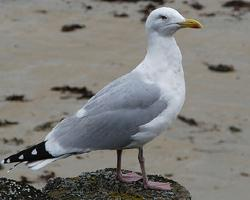
Veszélyeztetettség
| Veszélyeztetett |
Állatleírás
The Dolphin Gull, scientifically named Leucophaeus scoresbii, is a distinctive bird species primarily found along the southern coasts of South America, including the Falkland Islands, and extending to the Antarctic Peninsula. This gull species is notable for its unique appearance and behaviors, setting it apart from other gull species in its habitat.Adult Dolphin Gulls have a striking appearance, characterized by their overall slate-gray plumage, which contrasts sharply with their white-tipped tail feathers and the white leading edges on their wings. One of the most remarkable features of this species is its bright red bill and legs, which are especially vivid in adults and serve as a striking visual feature against the often bleak and rocky backgrounds of their southern habitats. Their heads are slightly paler gray, and during the breeding season, they may display a faintly lighter hood. The eyes are encircled by a thin ring of red skin, adding to their distinctive look.
Juvenile Dolphin Gulls, in contrast, wear a mottled brown and gray plumage, which gradually transitions to the sleek gray adult plumage over a few years. This camouflage helps protect the younger birds from predators as they mature.
Dolphin Gulls are medium-sized birds, with a robust build that is typical of many gull species. They possess a powerful flight, capable of swift maneuvers over the coastal waters they predominantly inhabit. Their diet is opportunistic and varied, consisting mainly of marine invertebrates, small fish, and carrion. They are known to follow marine mammals, such as seals and dolphins, to feed on the leftovers of their prey, hence their common name. This behavior, along with their scavenging tendencies, highlights their adaptability and resourcefulness in the harsh southern ecosystems.
Breeding typically occurs in colonies, where Dolphin Gulls establish territories and nest on the ground, often on islands or remote coastal areas to minimize disturbance from predators. Their nests are simple scrapes in the ground, sometimes lined with vegetation or feathers. The female typically lays 2 to 3 eggs, which both parents then incubate. The chicks are precocial, meaning they are relatively mature and mobile from the moment of hatching, though they remain dependent on their parents for food and protection for several weeks.
The Dolphin Gull plays a vital role in its ecosystem as both a predator and scavenger, helping to control populations of smaller marine creatures and contributing to the nutrient cycle by cleaning up carrion and organic waste.
Despite their resilience and adaptability, like many seabirds, Dolphin Gulls face threats from pollution, habitat loss, and changes in food availability due to overfishing and climate change. While currently not listed as endangered, their well-being is closely tied to the health of their marine environment, making them indicators of the overall ecological health of their southern ocean habitats. Conservation efforts aimed at protecting their breeding grounds and ensuring sustainable fishing practices are crucial for the continued survival of this unique and captivating seabird species.
Hasonló állatok
Új állatfotók
Top 10 állat
- Dolphin gull (Leucophaeus scoresbii)
- Diana monkey (Cercopithecus diana)
- Moustached guenon (Cercopithecus cephus)
- Galápagos tortoise (Geochelone nigra complex)
- Japanese macaque (Macaca fuscata)
- Stone loach (Barbatula barbatula)
- Russian tortoise (Testudo horsfieldii)
- Greek tortoise (Testudo graeca)
- Common flying dragon (Draco volans)
- Vendace (Coregonus albula)


